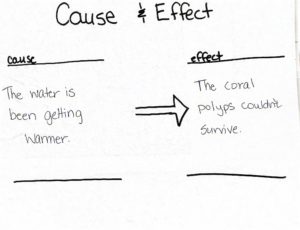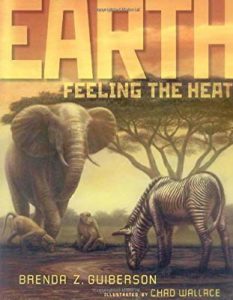In my search for engaging texts that would fit a cause and effect nonfiction structure, I found this gem! Even though I was on a mission, this one caught me because of the cover. The cover has a beautiful, safari-like scene that feels very peaceful.
Why I Finished It:
I read this extremely engaging book about four times in a row! First, I looked through because, as I mentioned above, I was on a mission: find the cause and effect relationship in the book. The second time, I was captivated by the language, facts, and my emotionally-charged response to the theme of the book. The third time I studied the pictures, which are stunning pieces of art. The final time I took it all in and thought about global warming and how the animals are being affected by climate change. Each page, in just a few sentences, explains how a specific animal and its environment is being affected by the warming climate. The final statement on each page is: “Who can help the ___?”
Who I Would Give It To:
This is a great book for science and ELA/R integration, as well as a strong picture book for teaching cause and effect. I would also think that families concerned with the environment would love to add this to their personal collection.
Integration Ideas:
Playful Language ~ Onomatopoeia (and Media Literacy)
On each page, there are sounds that provide imagery for the reader. There is the “Dripdripdrip” of the ice, “Flitflitflit” of the butterfly, and “swishswish” of filefish.
Work with students to translate sounds into text. Provide objects or pictures of objects for students and, as a class, brainstorm the sound associated. Some examples might be a phone, a pig, a wind chime, etc. The following day, take the students to the playground and have them choose one piece of equipment and play. While playing, ask them to pay attention to the sounds they hear. Do they hear the wind moving? The leaves crackling? A child laughing? When they come back in the class, each student should write three sentences about their time on the equipment. You can provide a sentence frame for the first two sentences:
While _____________________________ at the playground. ______[sound]________!
Older students might want to write a commercial instead of going to the playground! Look at Rice Krispies commercials (Snap, Crackle, and Pop!). There are also other commercials that include onomatopoeia, including Bissell, Coca-Cola, and others.
Discuss the sounds and how they are catchy. Spend time looking at Media Literacy, talk about how the catchy slogan might help sell their product. Then have them choose a product and write their own catchy slogan.
Another fun extension for onomatopoeia is to look at comic books and create comics with students.
Action Research and Debate
I am not one to shy away from a controversial topic! If this does not sound like you, skip this section and look at expository text structure!
Okay my little pot stirrers…global warming is quite the topic. Do your best to keep politics out and let the students read and/or research evidence for and again global warming. Now, there is no debate as to whether the Earth is warming – it is! There are plenty of scientific facts to support that. The debate really comes down to what is responsible for global warming. After reading and gathering research, allow time for students to either discuss or debate what they think based on what they read.
Finally, the warming of our planet is a problem, regardless of the cause. Have students generate ideas of what can be done or solutions they have. Provide time for students to follow through on one or more of the ideas. Everyone doesn’t have to do the same idea, but everyone should do something.
Expository Text Structure ~ Cause and Effect
It is so important to teach even the youngest kids about the different nonfiction text structures. When readers understand that texts have an embedded structure, they will have a plan when they read. If they are reading a cause and effect text and they just read something happened, then they know they need to look for the cause(s). Provide students with a graphic organizer that illustrates the structure. Please remember, that students will eventually need to be able to make the organizer themselves, so keep it simple! As you read the text, model for students how to fill out the organizer. During processing time, students should read their own cause and effect text and fill out their own graphic organizer.
Don’t forget to use the same organizer to plan their own writing!
Writing
Brainstorm a list of cause and effect relationships. These can come from their personal experiences, science, social studies, etc. Have students choose one topic and conduct informal research on the topic. Collect information on the cause and effects. They should fill out the same type of organizer used during reading. Once the organizer is done, you can stop there, or you can have students generate a cause and effect paragraph or essay.
Author’s Website – http://www.brendazguiberson.com/
How will you use this book?








Leave a Reply